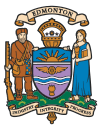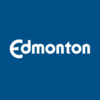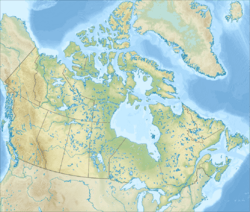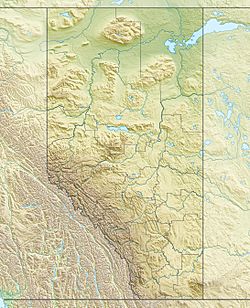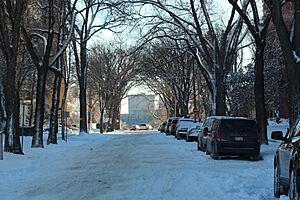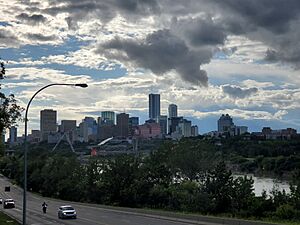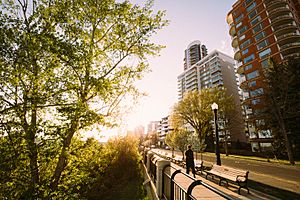Edmonton facts for kids
Quick facts for kids
Edmonton
|
|||||
|---|---|---|---|---|---|
| City of Edmonton | |||||
|
Walterdale Bridge and Downtown Edmonton skyline
Law Courts Building
|
|||||
|
|||||
| Nicknames:
Canada's Festival City, City of Champions, The Oil Capital of Canada more...
|
|||||
| Motto(s):
Industry, integrity, progress
|
|||||
| Country | Canada | ||||
| Province | Alberta | ||||
| Region | Edmonton Metropolitan Region | ||||
| Census division | 11 | ||||
| Adjacent Specialized municipality | Strathcona County | ||||
| Adjacent municipal districts | Leduc County, Parkland County and Sturgeon County | ||||
| Founded | 1795 | ||||
| Incorporated | |||||
| • Town | January 9, 1892 | ||||
| • City | October 8, 1904 | ||||
| Amalgamated | February 12, 1912 | ||||
| Named for | Edmonton, London | ||||
| Area
(2021)
|
|||||
| • Land | 765.61 km2 (295.60 sq mi) | ||||
| • Urban | 627.20 km2 (242.16 sq mi) | ||||
| • Metro | 9,416.19 km2 (3,635.61 sq mi) | ||||
| Elevation | 645 m (2,116 ft) | ||||
| Population
(2021)
|
|||||
| • City | 1,010,899 (5th) | ||||
| • Estimate
(2023)
|
1,128,811 | ||||
| • Density | 1,320.4/km2 (3,420/sq mi) | ||||
| • Urban | 1,151,635 (5th) | ||||
| • Urban density | 1,836.2/km2 (4,756/sq mi) | ||||
| • Metro | 1,418,118 (6th) | ||||
| • Metro density | 150.6/km2 (390/sq mi) | ||||
| • Municipal census (2019) | 972,223 | ||||
| Demonym(s) | Edmontonian | ||||
| Time zone | UTC−07:00 (MST) | ||||
| • Summer (DST) | UTC−06:00 (MDT) | ||||
| FSAs |
T5A – T6Y
|
||||
| Area codes | 780, 587, 825, 368 | ||||
| NTS Map | 83H5 Leduc, 83H6 Cooking Lake, 83H11 Edmonton, 83H12 St. Albert | ||||
| GNBC Code | IACMP | ||||
| GDP (Edmonton CMA) | CA$87.48 billion (2020) | ||||
| GDP per capita (Edmonton CMA) | CA$63,601 (2022) | ||||
Edmonton is the capital city of Alberta, a Canadian province. It sits on the North Saskatchewan River and is the main city of the Edmonton Metropolitan Region. This area is often called the "Gateway to the North" because it's a starting point for big projects in northern Alberta.
Edmonton is also known as "Canada's Festival City" because it hosts many festivals all year long. It's home to West Edmonton Mall, one of North America's largest shopping malls, and Fort Edmonton Park, Canada's biggest living history museum.
Long ago, Indigenous peoples and Métis people lived in the Edmonton area. Trading posts were set up here by 1795. The main trading post, "Fort Edmonton," became very important after two big fur trading companies joined together in 1821.
The city grew a lot after the Canadian Pacific Railway arrived in 1891. Edmonton became a town in 1892 and then a city in 1904. In 1906, it was chosen as the capital of the new province of Alberta. Over the years, Edmonton grew by adding nearby towns and land.
As of 2021, Edmonton had over 1 million people living in the city and more than 1.4 million in the wider metropolitan area. This makes it one of the largest cities in Canada. People who live in Edmonton are called Edmontonians.
Contents
What's in a Name?
The name Edmonton comes from a trading post called Fort Edmonton. This fort was named after a place in England called Edmonton, London. The person who built the fort, William Tomison, chose the name because it was the hometown of the Lake family, who were important members of the Hudson's Bay Company.
The word "Edmonton" itself comes from an old English name, Ēadhelm, and a word meaning 'farmstead' or 'estate'.
Indigenous peoples had their own names for the Edmonton area, often talking about the fur trading posts. In Cree, it's called ᐊᒥᐢᑿᒌᐚᐢᑲᐦᐃᑲᐣ (amiskwacîwâskahikan), meaning "Beaver Hills House." In Blackfoot, it's Omahkoyis, meaning 'big lodge'.
Edmonton's Story
People first lived in the Edmonton area around 3,000 BC, or maybe even as early as 12,000 BC. This was when the ice from the last ice age melted, and the land became good for living, with trees, water, and animals.
Many Indigenous groups, like the Cree, Nakota Sioux, and Blackfoot, lived here. The North Saskatchewan River valley was a very important place for them. It provided food, medicine, and materials for tools like axes and knives.
The Métis people also had many narrow plots of land along the river. These plots gave them access to the river's resources.
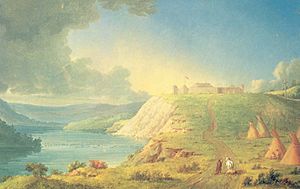
In 1754, Anthony Henday, an explorer for the Hudson's Bay Company, might have been the first European to visit the Edmonton area. He was looking to trade furs with Indigenous peoples.
By 1795, Fort Edmonton was built as a major trading post. It was near a rival fort, Fort Augustus. Both forts moved upstream over time. By 1813, Fort Edmonton was in the area of today's Rossdale, marking the start of a permanent settlement.
In 1876, Treaty 6 was signed between Indigenous groups and the Canadian government. This treaty covered a large area, including what is now Edmonton.
The arrival of the Canadian Pacific Railway in 1885 helped Edmonton's economy. Then, the Calgary and Edmonton Railway in 1891 led to a new railway town, Strathcona, on the south side of the river. These railways brought many new settlers and business people from Canada, Europe, and the U.S.
Edmonton's rich soil and cheap land attracted many farmers. This helped Edmonton become a big centre for trade and farming. Some people heading to the Klondike Gold Rush in 1897 passed through Strathcona.
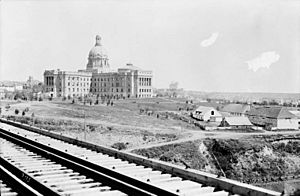
Edmonton became a town in 1892 with 700 people. It became a city in 1904 with 8,350 people. On September 1, 1905, Edmonton was chosen as the capital of Alberta. The Canadian Northern Railway arrived in 1905, making the city grow even faster.
In 1912, Edmonton joined with the City of Strathcona. This meant Edmonton now owned land on both sides of the North Saskatchewan River.
Before World War I, Edmonton's fast growth slowed down. The population dropped from over 72,000 in 1914 to less than 54,000 two years later. Many people moved to farms or other provinces. The city slowly recovered in the 1920s and 1930s, then grew quickly again during and after World War II.
The Edmonton City Centre Airport opened in 1929. It became a key base for sending mail, food, and medicine to Northern Canada. This helped Edmonton become known as the "Gateway to the North." The airport closed in 2013.
On July 31, 1987, a very strong tornado hit the city, sadly killing 27 people. This day became known as "Black Friday." The way the community helped each other after the tornado led to Edmonton being called the "City of Champions."
Where is Edmonton?
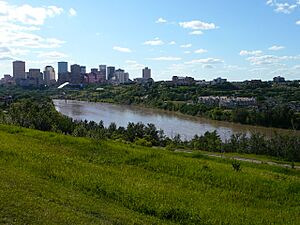
Edmonton is located on the North Saskatchewan River. It is about 671 meters (2,201 feet) above sea level. It is the most northern city in North America with over a million people. The land around Edmonton is mostly flat or gently rolling, with deep river valleys and ravines. The Canadian Rockies mountains are about 220 kilometers (137 miles) to the southwest.
The North Saskatchewan River starts at the Columbia Icefield in Jasper National Park. It flows through the middle of Edmonton. Sometimes, the river valley floods, like in 1915. Many smaller creeks flow into the river, creating ravines that are now used as parks.
Edmonton is surrounded by aspen parkland. This is a special area where the flat prairies meet the northern forests. Much of the original aspen woods have been cleared for farms and buildings.
Edmonton's Weather
Edmonton has a climate with cold, dry winters and warm, sunny summers. The weather can change a lot throughout the year. Summer usually lasts from June to early September, and winter from November to March. Spring and autumn are short and changeable.
Edmonton gets about 2,344 hours of sunshine each year, making it one of Canada's sunniest cities. In summer, the sun stays out for over 17 hours a day.
Winters are known for being cold, but they are often milder than in other Canadian cities like Regina or Winnipeg. The average temperature in January is about -10.4°C (13.3°F), and in July, it's about 17.7°C (63.9°F). Temperatures can go above 30°C (86°F) in summer and below -20°C (-4°F) in winter. The coldest temperature ever recorded was -49.4°C (-56.9°F) in 1886.
Edmonton is fairly dry, getting about 455.7 mm (17.9 inches) of rain and snow each year. Most of the rain falls in late spring, summer, and early autumn. July is usually the wettest month. Snowfall typically starts in late October and ends by late March. Summer thunderstorms are common and can sometimes bring heavy rain or hail.
Greater Edmonton Area
Edmonton is the centre of Canada's sixth-largest metropolitan area. This area includes Edmonton and 34 other nearby towns and cities. Some of the larger communities are Sherwood Park, St. Albert, Beaumont, Leduc, Spruce Grove, and Fort Saskatchewan.
This wider area also has important industrial zones, like the Nisku Industrial Business Park and Refinery Row. These areas are important for jobs and the economy.
Over the years, Edmonton has grown by adding land from its neighbours. For example, on January 1, 2019, Edmonton officially added about 8,260 hectares (20,411 acres) of land from Leduc County and Beaumont.
City Neighbourhoods
Edmonton is divided into 375 neighbourhoods. These are grouped into seven main areas. The "mature area" includes older neighbourhoods built before 1970, like Downtown and its surrounding areas.
Some of the most populated neighbourhoods are Oliver and Garneau. The city has also grown by adding five former towns: Beverly, Jasper Place, North Edmonton, Strathcona, and West Edmonton.
Newer residential areas are found in the six suburban sectors around the city. These include places like Heritage Valley, Mill Woods, and Castle Downs. Each of these larger areas has many smaller neighbourhoods within them.
Some new communities are being built around the LRT (light rail train) lines. For example, the former City Centre Airport is being turned into a new community called Blatchford, which will have homes, shops, and parks.
Edmonton also has four main industrial areas where many businesses and factories are located. There are also 12 "business revitalization zones" that help improve and promote local shopping and business areas.
People of Edmonton
Ethnic groups in Edmonton from the 2021 census European (51.39%) South Asian (11.54%) Southeast Asian (9.01%) Black (7.58%) East Asian (7.02%) Indigenous (5.84%) Middle Eastern (3.83%) Latin American (1.95%) Other (1.84%)
In 2021, the City of Edmonton had a population of 1,010,899 people. The wider Edmonton metropolitan area had 1,418,118 people. This makes Edmonton one of the largest cities in Canada.
Edmonton is a very diverse city. Many people from all over the world have chosen to make Edmonton their home. In 2021, about 32.5% of Edmonton's population were immigrants, meaning they were born outside Canada. The largest groups of immigrants came from the Philippines, India, and China.
About half of Edmonton's population (51.4%) are of European backgrounds, including English, Scottish, German, and Irish. Many people also identify as Canadian. Other large ethnic groups include East and Southeast Asian (like Filipino and Chinese), South Asian (like Indian), Indigenous, Black, Latin American, and Middle Eastern.
Religions in Edmonton
Edmonton religious affiliation (2021) Christianity (44.6%) Islam (8.3%) Sikhism (4.2%) Hinduism (3.4%) Buddhism (1.5%) Judaism (0.4%) Indigenous spirituality (0.2%) Other religion (1.0%) Irreligion (36.4%)
Edmonton is home to people of many different faiths. In 2021, about 44.6% of people in the Edmonton area identified as Christian. The largest Christian group is Roman Catholic.
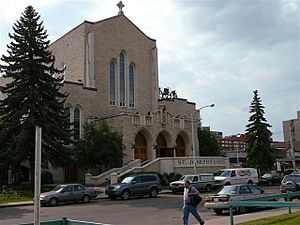
Other important religious groups include Muslims (8.3%), Sikhs (4.1%), Hindus (3.4%), and Buddhists (1.5%). About 36.4% of people said they had no religious affiliation.
Edmonton has many places of worship, including churches, mosques, temples, and synagogues. The Al-Rashid Mosque, built in 1938, was the first mosque in Canada.
Edmonton's Economy
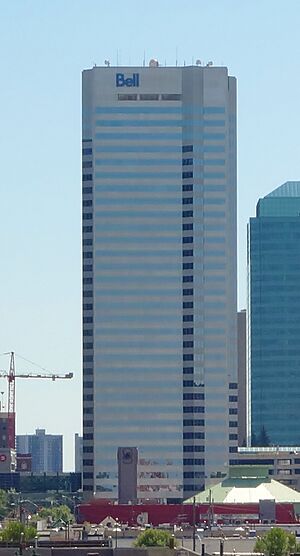
Edmonton is a major economic hub for northern and central Alberta. It's especially important for the oil and gas industry. Because of this, it was nicknamed "Oil Capital of Canada" in the 1940s. Many companies here provide services and supplies for oil and gas projects.
Edmonton is also a growing centre for technology. This is partly because of its strong research and education institutions, like the University of Alberta. The university campus is home to the National Institute for Nanotechnology, which studies very tiny materials.
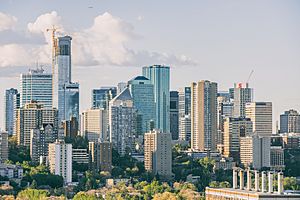
In the past, Edmonton also became a big financial centre. Today, it's home to Canadian Western Bank, the only publicly traded bank headquartered west of Toronto. Many well-known Canadian companies, like The Brick (furniture) and Boston Pizza, started in Edmonton. Bioware, a video game company, is also based here.
Edmonton's location makes it a great place for shipping and logistics. CN Rail, a major railway company, has its North American operations centre in the city.
Shopping in Edmonton
Edmonton has many shopping malls, including West Edmonton Mall, which is the second-largest mall in North America. It was the world's largest mall from 1981 to 2004. Other big malls include Southgate Centre and Kingsway Mall.
You can also find many "big box" stores and outdoor shopping centres, like South Edmonton Common, which is one of North America's largest outdoor retail areas.
For a different shopping experience, Old Strathcona is a popular area with many unique independent stores. It also has the city's largest indoor farmer's market, where you can find local food, crafts, and clothing. Downtown Edmonton and 124 Street also have many shops and galleries.
Arts and Fun
Edmonton has a lively arts and culture scene. Many events happen in the downtown Arts District around Churchill Square. On the south side of the river, near the university and Whyte Avenue, you'll find theatres, concert halls, and live music venues.
Live Shows and Music
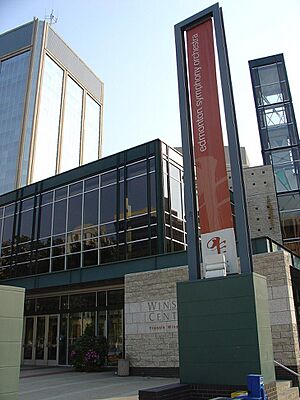
The Francis Winspear Centre for Music is known for its amazing sound. It's home to the Edmonton Symphony Orchestra and hosts many concerts. It has a huge concert organ, one of the largest in Canada.
Nearby is the Citadel Theatre, one of Canada's biggest theatre complexes. It has five different halls for various types of plays. The Northern Alberta Jubilee Auditorium, on the University of Alberta campus, hosts concerts, musicals, and ballets.
The Old Strathcona neighbourhood is also a theatre hub. It has the ATB Financial Arts Barns, which is the main spot for the Edmonton International Fringe Festival.
Festivals Galore!
Edmonton is famous for its many festivals, earning it the nickname "Canada's Festival City." Churchill Square downtown hosts several festivals every summer. The Works Art & Design Festival shows off Canadian and international art. The Edmonton International Street Performer's Festival in mid-July is the biggest of its kind in North America.
Edmonton's main summer festival is K-Days. It started in 1879 as a fair and later had a gold rush theme. It's a big event with rides, games, and shows. The Canadian Finals Rodeo also takes place in Edmonton.
The Edmonton International Fringe Festival in August is the largest fringe theatre festival in North America. The Edmonton Folk Music Festival is also held in August and is one of Canada's biggest folk music events. Other summer festivals include the Edmonton Heritage Festival and Taste of Edmonton. Edmonton also has winter festivals like the Silver Skate Festival.
Music Scene
Edmonton has a long history of music, from church choirs to classical orchestras. The Edmonton Symphony Orchestra has been around since 1913 and performs at the Francis Winspear Centre for Music.
The city also has a lively popular music scene, with many local bands and artists in different styles like hip-hop, rock, country, and electronic music. Famous musicians from Edmonton include Robert Goulet and Ruth B..
Nightlife and Entertainment
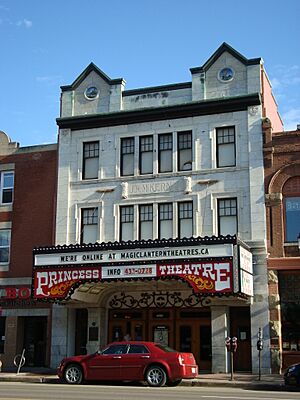
Edmonton has several popular areas for nightlife. The most popular is the Whyte Avenue strip. It has many historic buildings, bars, clubs, and restaurants. Because it's close to the University of Alberta, it's a popular spot for students and young adults. This area also has two old movie theatres, the Garneau and Princess, and places for live theatre and comedy.
Downtown Edmonton has also seen a lot of new development. You can find many pubs, hotel lounges, and restaurants along Jasper Avenue. The Edmonton City Centre mall has a movie theatre.
West Edmonton Mall also has many entertainment options after hours. Bourbon Street inside the mall has restaurants, and there are clubs and casinos. The mall also has a large movie theatre with an IMAX screen.
Fun Things to Do
Edmonton is known for its beautiful nature, delicious food, interesting history, and great facilities. It's home to Fort Edmonton Park, Canada's largest living history museum, and West Edmonton Mall, North America's largest shopping mall.
Other popular attractions include the Royal Alberta Museum, the Muttart Conservatory (with its unique glass pyramids), the Alberta Legislature Building, the Art Gallery of Alberta, and the Edmonton Valley Zoo.
Parks and Nature
Edmonton's river valley is the longest stretch of connected urban parkland in North America. It's 22 times bigger than New York City's Central Park! Edmonton also has the most parkland per person of any Canadian city.
This "Ribbon of Green" includes many parks, lakes, and ravines. There are over 111 square kilometers (43 square miles) of parkland in total. The river valley park system has 11 lakes, 14 ravines, and 22 major parks. Most of the city has easy access to bike and walking trails. These trails are also part of the 235-kilometer (146-mile) Waskahegan Trail.

Edmonton's streets and parks have many healthy American elm trees, which are rare in other parts of North America. You can also find many other types of trees like pine, spruce, birch, and maple.
Several golf courses are located in the river valley. In winter, the parks become a great place for cross-country skiing and skating. There are also four downhill ski slopes in or near the river valley.
The Edmonton & Area Land Trust helps protect natural areas in and around Edmonton. One of their projects is the Larch Sanctuary, which has the only oxbow lake in the city. Many volunteers help keep Edmonton's parks clean and healthy.
Museums and Art
Edmonton has many museums. The biggest is the Royal Alberta Museum (RAM). It has over 10 million objects, showing the history and cultures of the region's Indigenous peoples. In 2018, the museum moved to a new building downtown.
The Telus World of Science is a fun place to learn about science. It has five permanent galleries, an IMAX theatre, a planetarium, and an observatory. The Edmonton Valley Zoo is also a popular spot.
The Alberta Aviation Museum is in a hangar at the old City Centre Airport. It has a collection of civilian and military aircraft. The Prince of Wales Armouries Heritage Centre is home to the Loyal Edmonton Regiment Military Museum, which tells the story of Edmonton's military history.
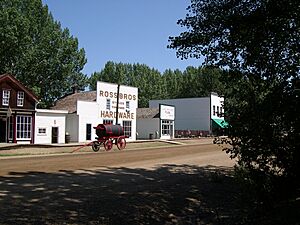
The Alberta Railway Museum in northeast Edmonton has old locomotives and railroad cars. It's only open in the summer because most of its exhibits are outdoors.
Fort Edmonton Park is Canada's largest living history museum. It shows Edmonton's history from 1795 to 1929 with historical buildings, costumed actors, and old artifacts. You can even ride a steam train or streetcars there!
The Art Gallery of Alberta (AGA) is the city's largest art gallery. It has over 5,000 pieces of art. The current building, designed by Randall Stout, opened in 2010. You can also find many smaller art galleries along the 124 Street/Jasper Avenue area.
Sports and Recreation
Edmonton has many professional sports teams. These include the Edmonton Elks (Canadian football), Edmonton Oilers (ice hockey), and Edmonton Stingers (basketball). The city also has junior and amateur sports teams.
The Oilers play at Rogers Place, and the Elks play at Commonwealth Stadium. Games between Edmonton and Calgary teams are often called the "Battle of Alberta" because they are big rivals.
Edmonton has hosted many major sporting events, including the 1978 Commonwealth Games and several FIFA Women's World Cup matches.


| Club | Type | League | Venue | Established | Championships |
|---|---|---|---|---|---|
| Edmonton Elks | Canadian football | Canadian Football League | Commonwealth Stadium | 1949 | 14 |
| Edmonton Oilers | Ice hockey | National Hockey League | Rogers Place | 1972 | 5 |
| Edmonton Stingers | Basketball | Canadian Elite Basketball League | Edmonton Expo Centre | 2018 | 2 |
| Club | Type | League | Venue | Established | Championships |
|---|---|---|---|---|---|
| Edmonton Huskies | Canadian football | Canadian Junior Football League | Clarke Stadium | 1947 | 5 |
| Edmonton Wildcats | Canadian football | Canadian Junior Football League | Clarke Stadium | 1948 | 3 |
| Edmonton Storm | Canadian football | Western Women's Canadian Football League | Clarke Stadium | 2004 | 0 |
| Edmonton Prospects | Baseball | Western Canadian Baseball League | Centennial Park Field, Sherwood Park | 2005 | 0 |
| Edmonton Riverhawks | Baseball | West Coast League | RE/MAX Field | 2020 | 0 |
| Edmonton Oil Kings | Ice hockey | Western Hockey League | Rogers Place | 2007 | 3 |
| Edmonton BTB SC | Soccer | League1 Alberta | Clarke Stadium | 2013 | |
| Edmonton Scottish | Soccer | League1 Alberta | Hamish Black Field | 1909 |
City Services
Getting Around Edmonton
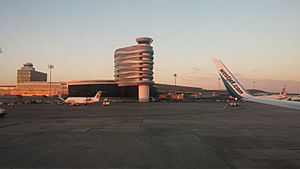
Edmonton is a major travel hub for northern Alberta and northern Canada. The Edmonton International Airport (YEG) is the main airport. It has flights to the United States, Europe, Mexico, and the Caribbean. The airport is working to become a big shipping hub called Port Alberta.
Edmonton is also a major centre for Canadian National Railway. Their North American operations are managed from their Edmonton offices.
The Edmonton Transit Service (ETS) runs the city's public transportation. This includes the Edmonton Light Rail Transit (LRT) system and a large fleet of buses. In 2017, over 86 million people used ETS services.
The LRT started in 1978. Edmonton's LRT was one of the first "modern" light rail lines in North America built in a city with under a million people. It also introduced a special ticket system that many other cities later copied. New parts of the LRT line have opened over the years, connecting more areas of the city.
Most of Edmonton's streets are laid out in a grid, with streets running north-south and avenues running east-west. Major roads like Yellowhead Trail and Anthony Henday Drive help people get around the city. Anthony Henday Drive is a main ring road that goes around the city.
Edmonton also has over 160 kilometers (99 miles) of multi-use trails, mostly in the river valley parks. These are great for walking, biking, and running.
Power and Water
Edmonton's first power company started in 1891, putting streetlights on Jasper Avenue. The city bought the power company in 1902, and it's now called EPCOR. EPCOR also handles water treatment. In 2002, they installed the world's largest ultraviolet (UV) water treatment system at their E. L. Smith Water Treatment Plant.
Waste Management
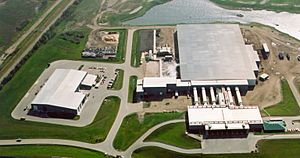
Edmonton has a system for collecting waste where residents separate their garbage, organic waste (like food scraps), and recycling. Organic waste goes into green bins, recycling into blue bags, and garbage into black bins. This program helps the city manage its waste better.
An anaerobic digester started working in 2021. It can process 40,000 tonnes of organic waste each year, turning it into high-quality compost and creating renewable heat and electricity. The city also sells the compost made at this facility.
The Edmonton Composting Facility was once the largest of its kind in the world. It used to turn Christmas trees into wood chips for composting. However, this facility was closed in 2019 due to structural problems.
Learning in Edmonton
Schools for Kids

Edmonton has three publicly funded school boards for kindergarten to grade 12. Most students attend schools in Edmonton Public Schools or the Edmonton Catholic School District. There's also a school board for French-speaking students, the Greater North Central Francophone Education Region No. 2. The city also has some public charter schools and private schools. All these schools get money from the province and property taxes.
Edmonton Public Schools is known for letting individual schools make more decisions about their programs. This means students have more choices about which school to attend based on their interests.
Colleges and Universities
Edmonton has several publicly funded colleges and universities. These include Concordia University of Edmonton, MacEwan University, NorQuest College, the Northern Alberta Institute of Technology (NAIT), and the University of Alberta (U of A).
The University of Alberta is a very large university with over 40,000 students. It offers more than 700 programs. It also has the second-largest research library system in Canada.
MacEwan University has over 18,000 students, offering bachelor's degrees, diplomas, and certificates. NAIT has about 41,000 students in over 200 programs, and NorQuest College has about 21,000 students.
Other colleges in Edmonton include King's University (private) and Yellowhead Tribal College (an Indigenous college).
News and Media
Edmonton has seven local TV stations, like CTV Edmonton and CBC TV Edmonton. You can watch them on cable or with an antenna. There are also many radio stations, both FM and AM.
The city has two main daily newspapers: the Edmonton Journal and the Edmonton Sun. The Journal started in 1903, and the Sun started in 1978. Both newspapers are owned by the Postmedia Network. There are also smaller weekly and community newspapers.
Friendly Cities Around the World
Edmonton has five sister cities and two partner cities around the world. These connections help Edmonton build friendships and share ideas with other cities.
 Gatineau, Quebec, Canada (1967)
Gatineau, Quebec, Canada (1967) Harbin, China (1985)
Harbin, China (1985) Nashville, Tennessee, United States (1990)
Nashville, Tennessee, United States (1990) Wonju, South Korea (1998)
Wonju, South Korea (1998) Bergen op Zoom, the Netherlands (2013)
Bergen op Zoom, the Netherlands (2013)
Partner cities
In 1990, Edmonton became the first sister city of Nashville, Tennessee. Leaders from both cities visit each other to celebrate their friendship.
Images for kids
-
Edmonton City Hall is where the city government works.
See also
 In Spanish: Edmonton para niños
In Spanish: Edmonton para niños










